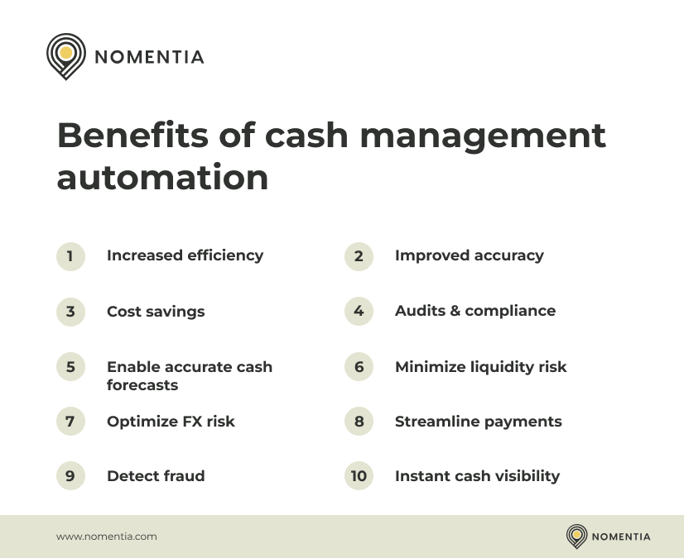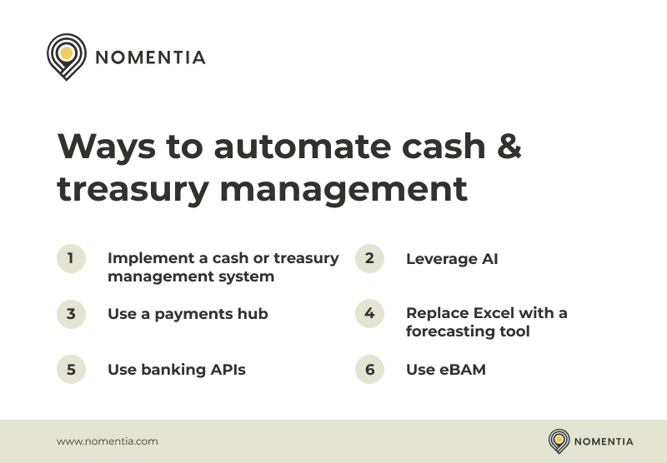Effective cash management can mean the difference between company failure and success. It has become an increasingly important topic for finance teams to manage cash as well and as efficiently as possible to enable business continuity.
Simultaneously, cash management can be a significant burden when companies start increasing in size due to the incremental complexity of their setups and varying legislation in different countries. Efficiently managing data centrally is close to impossible when you start using several accounts at different banks, ERP systems, and other financial systems. Especially so when your team and company are also increasing in size, and you become dependent on the input of several stakeholders in the process. On top of that, it is typically challenging for companies to get instant or real-time visibility into group-wide cash positions and cash flow details, resulting in unwanted liquidity risks that can be harder to foresee.
Manual cash management requires significant time and resources and is often highly prone to error. Yet, most routine tasks that are done manually can easily be automated with the right solutions. Different strategies exist to automate cash management, and automation comes with several key benefits.
What is cash management automation?
Cash management automation is the process of automating tasks that are typically manually done, such as data collection, information reporting, capital management, currency management, and financial risk management. Automating such tasks helps companies become more efficient with their resources.
The benefits of cash management automation
There are various benefits to automating cash management. These are some of the benefits most companies experience when automating their cash management processes:

1. It leads to increased efficiency
The main benefit of automating your cash management is increased efficiency. Automation with the right tool provides fast and error-free processes. It also removes manual tasks such as collecting and combining data from different sources, user access management, and reporting, especially in real-time. Streamlining processes with the help of automation typically also comes with audit trails that will help you mitigate potential fraud attempts.
2. Accuracy starts improving
If you are reporting on your cash flows in an Excel sheet and you manually enter data from several source systems, banks, or entities, the chances are high that mistakes will occur that could potentially endanger the company’s liquidity. Certainly, when several people are working on the same Excel file, and you are dependent on the accuracy of data entries from several subsidiaries, for example. Instead, automatically retrieving all data directly from banks and source systems in a single source of truth will make such processes much more accurate. Accuracy and instant access to financial data will enable your finance team to make quick and informed strategic decisions as a result.
3. There are significant cost savings
Automation usually requires an initial investment, but the return on investment can outweigh the cost of a solution. You can save a significant number of hours with the entire finance team due to the standardization and automation of cash management processes. All the hours saved can be spent on other tasks that were previously neglected. Saving precious time also provides you with more time to analyze cash flow data, which in turn enables prompt decision-making for the company.
4. Easier to meet audit & compliance requirements
Audits and compliance become a lot easier with automated processes and centralized cash management. The requirements that auditors and compliance regulations impose are often easily extractable from automated cash management platforms. On top of that, most systems use audit trails, which allow you to see exactly what users have done in the system in the past. This information can be used for audits as well as to detect fraud or irregularities in cash flows.
5. It enables accurate cash forecasts
Automated cash management tools retrieve more accurate data directly from all source systems without any manual errors. Some tools even use predictive analytics based on historical data to forecast cash flows.
6. It helps minimize liquidity risk
The more accurate your cash flow data becomes due to automation, the better insight you gain into your liquidity risk. Automated tools also allow you to retrieve your liquidity position instantly at any point in time. This facilitates quick decision-making regarding external or internal funding and whether you are able to invest promptly in potential business opportunities.
7. Enable optimal FX risk management
Foreign exchange risk management comes with several challenges. Automated tools will enable you to tackle most challenges by capturing all trades and payments that are exposed to FX risk within a centralized place. The system automatically calculates the impact that the FX risk has on your liquidity positions with up-to-date FX rates.
8. Streamline payments and reconciliation
Fully automated payment solutions provide you with a complete payment hub for automating, managing, and centralizing local, cross-border, and global payments. Automatically connect ERPs, financial systems, and banks to process outgoing payments for accounts payable, treasury, payroll, and manual payments to gain more visibility and control over where your cash is going. With automated payment reconciliation and the right posting rules, your payment matching processes will allow you to process payment batches without worrying about where payments are transferred.
9. Detect fraudulent payments
Through automated workflow settings in payment reconciliation processes, irregular payments stand out immediately. This helps prevent your company from executing fraudulent or erroneous payments. Automated sanctions screening can additionally help eliminate illegitimate payments by automatically screening your outgoing payments against lists with sanctioned counterparties. Both processes are highly time-consuming when performed manually.
10. Boost transparency with instant global cash visibility
Automation with the right tools can provide you with instant global cash visibility in one platform by combining all the available data throughout the entire organization regardless of the number of banks, ERP systems, subsidiaries, entities, financial systems, or any other source systems.
Different ways to automate cash and treasury management
There are several ways to start automating cash and treasury management successfully. These are some of the main strategies used to enable automation:

1. Get a cash or treasury management system
The best way to automate your cash management is to consolidate all data into one system, such as a cash or treasury management system. The need to consult different systems, employees, entities, and bank accounts disappears when you centralize all your data into one platform where you can also manage it. Some cash and treasury management systems enable you to manage almost everything in one platform: FX risk, guarantees, loans, liquidity, cash forecasting, bank accounts, reconciliation, payments, sanctions screening, bank connections, bank fee management, reporting, trade finance, ERP connectivity, and more.
2. Leverage artificial intelligence (AI)
Some solutions allow you to leverage artificial intelligence, mostly to automate routine tasks and predictable processes. Even though treasury and cash management are still in their early stages, there are cash forecasting solutions that use AI or machine learning to detect seasonality trends or historical patterns and use that information for future cash flow forecasting scenarios.
3. Use a single source of truth payment platform
When it comes to payments, there are solutions that automate most of the process by controlling and managing all payments end-to-end by combining payment data from different sources, such as banks and ERP systems. With some tools, you can even use payment reconciliation to automate payment matching processes. For many companies with a high number of transactions, this is an important strategy to make payment processes more efficient.
4. Replace Excel with a cash forecasting tool
Most businesses that do their cash flow forecasting in Excel struggle with the manual work and errors that the process is known for. When companies grow, Excel forecasts become increasingly difficult to manage. This is when cash flow forecasting tools start to become interesting for finance teams as they provide the automation necessary to reduce inaccuracies and time spent on the process.
5. Use banking APIs
Some banks offer APIs to automate some treasury or cash management tasks. J.P. Morgan, for example, offers an API to automatically retrieve real-time data from several of its bank accounts into one spreadsheet, allowing you to have better cash visibility in a matter of seconds or minutes.
Though APIs are becoming increasingly popular, they are not heavily adopted yet. APIs provided by one bank typically do not work with another bank. Hence, most companies with several banks automatically turn to cash and treasury management solutions instead because they can connect to all banks.
6. Use electronic bank account management
If your bank qualifies for eBAM, it can be worth having a look at automating some of your cash management. EBAMs allow you to manage several bank accounts centrally and completely electronically. In an eBAM solution you can for example manage the opening of bank accounts, maintenance of bank accounts, signatory rights and spending limits, the closing of bank accounts, and generation of reports for auditing and compliance purposes. The list is limited, but some of the banks that offer eBAM services are J.P. Morgan, Deutsche Bank, BNP Paribas, Citibank, and Bank of America Merrill Lynch.
Choosing the right automated cash management system
In the end, it is up to each cash and treasury team to use the best solutions to automate cash management processes. Investments in such systems need to be carefully considered, and different tools should be compared to see what best fits your company’s requirements. We wrote another article where you can compare the top 10 best cash management solutions to help you with this.
Despite the initial investment of a cash or treasury management system, the benefits of automating cash and treasury processes in companies with more complex set-ups usually outweigh the costs by far. Most treasurers and finance teams consider the implementation of cash management systems to be very heavy, but it is typically done with the help of support services from a solution provider. Depending on the complexity of your setup, implementation can actually be done in a matter of weeks or months.

